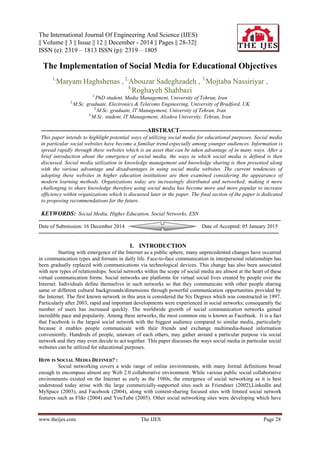The paper discusses the implementation of social media for educational objectives, highlighting its potential benefits and challenges in higher education. It examines the rapid evolution of social media and its role in facilitating knowledge sharing and informal learning, while also addressing concerns regarding trust and security. The authors recommend fostering teacher exploration of social media's educational potential and integrating it into modern teaching practices to enhance learning outcomes.




![The Implementation Of Social Media…
www.theijes.com The IJES Page 32
REFERENCES
[1] Yang, S. J. H., & Chen, I. Y. L. (2008). A Social Network-based System for Supporting Interactive Collaboration in Knowledge
Sharing over Peer-to-Peer Network. International Journal of Human-Computer Studies, 66 (1), 36-50.
[2] Chu, S.K.W. & Du, H. (2013). Social Networking Tools for Academic Libraries. Journal of Librarianship & Information Science,
45(1), 64-75.
[3] Wong, K., Kwan, R. & Leung, K. (2011). An Exploration of Using Facebook to Build a Virtual Community of Practice. Proceedings
of the 4th International Conference, ICHL 2011 (pp. 316-324), Hong Kong, China.
[4] Selwyn, N. (2009). Faceworking: exploring students‟ education-related use of Facebook, Learning, Media and Technology, 34(2),
157-174.
[5] Angeli, C., Bonk, C., and Hara, N. Content analysis of online discussion in an applied educational psychology course. [On-line]
(1998).
Maryam Haghshenas is born in 1985 and has earned B.Sc. degree in Computer Hardware engineering from
Islamic Azad University, South Tehran branch, Tehran, Iran in 2007. She then received a M.Sc. degree in IT
management at Islamic Azad University, Science & Research branch, Tehran, Iran in 2011 and is currently a
PhD student of media management in university of Tehran in Iran. She is IT expert in MAGFA ITDC as an
affiliate of the Industrial Development and Renovation Organization of Iran. She has more than 50 papers
presented at national and international conferences and has been published in prestigious journals. Ms.
Haghshenas is a member of Young Researchers Club at Islamic Azad University, Science &Research Branch in
Iran.
Abouzar Sadeghzadeh was born in 1985 and graduated with a B.Sc. honors degree in electronics and
telecommunications engineering from the University of Bradford, UK in 2006. He then completed a M.Sc.
degree in radio frequency and communications engineering the following year from the same university. His
M.Sc. thesis is titled “Mobile Information System” which concerns mobile technology and its uses. Upon
completing his studies he worked for Huawei Technologies as a project manager before joining various other
companies in IT fields namely IT consultancy in MAGFA ITDC (Information Technology Development
Center).
Mojtaba Nassiriyar was born in Tehran in 1983. He graduated with a B.Sc. degree in 2006 in industrial
management from the University of Tehran. His master‟s degree was completed in IT management in 2009. He
is IT expert in MAGFA ITDC. He has published three papers in the IT management field and has written a book
on IT service oriented and knowledge based projects management. He currently manages data center projects at
national level and teaches IT engineering management courses at Payam Noor University, Tehran.
Roghayeh Shahbazi was born in 1987 and has graduated with a B.Sc. degree in Applied Mathematics from
Arak University, Iran in 2010. She then graduated with a M.Sc. degree in IT management at Alzahra University,
Tehran, Iran in 2014. Her M.Sc. project was about the adoption of cloud computing and relevant investment
returns. She is an IT expert in MAGFA ITDC. Activity fields of MAGFA include the implementation of national
projects in BI and KM fields. In addition, she has over 3 years experience in IT consultancy.](https://image.slidesharecdn.com/e031203028032-150218035451-conversion-gate02/85/The-Implementation-of-Social-Media-for-Educational-Objectives-5-320.jpg)